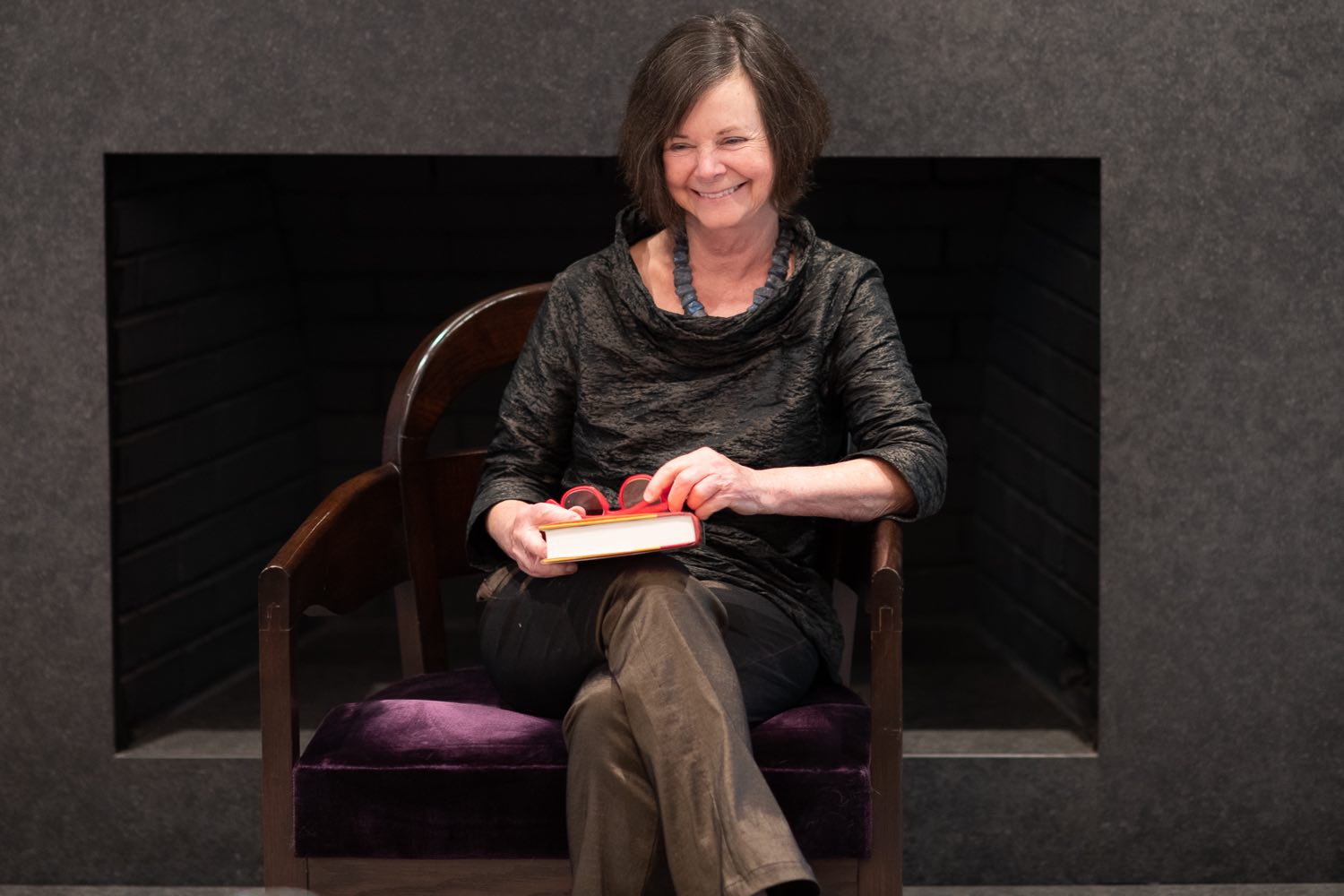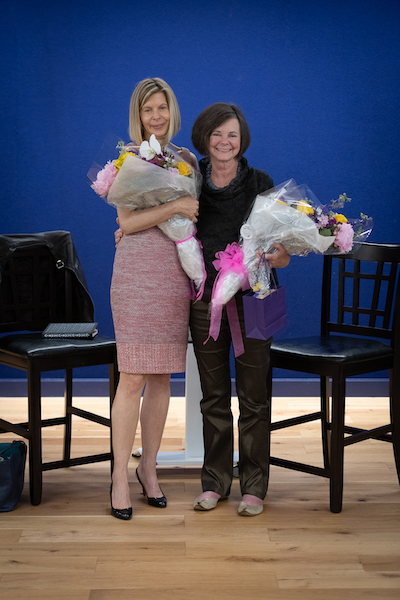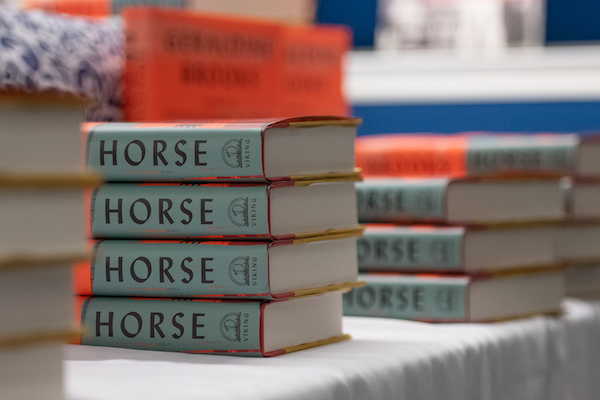Geraldine Brooks, Journalist Turned Novelist, Visits Scarsdale
- Monday, 19 June 2023 16:14
- Last Updated: Wednesday, 21 June 2023 13:54
- Published: Monday, 19 June 2023 16:14
- Joanne Wallenstein
- Hits: 1535
 Geraldine Brooks, the Pulitzer-prize-winning, bestselling author, came to the Scarsdale Library on Friday evening, June 16th, for a conversation with New York Times journalist, Sarah Lyall. Their talk was centered on Horse, Geraldine Brooks’ most recent novel, but the fascinating and moving discussion ranged across many topics including race relations, loss, grief, the current state of publishing, and more. And as anyone who has read her works of historical fiction (March, Crossing Caleb, Year of Wonders, People of the Book) knows, Brooks is a master of researching undiscovered stories and filling in the blanks to build characters and weave rich tales, based in truth and enhanced by her vivid imagination and evocative writing.
Geraldine Brooks, the Pulitzer-prize-winning, bestselling author, came to the Scarsdale Library on Friday evening, June 16th, for a conversation with New York Times journalist, Sarah Lyall. Their talk was centered on Horse, Geraldine Brooks’ most recent novel, but the fascinating and moving discussion ranged across many topics including race relations, loss, grief, the current state of publishing, and more. And as anyone who has read her works of historical fiction (March, Crossing Caleb, Year of Wonders, People of the Book) knows, Brooks is a master of researching undiscovered stories and filling in the blanks to build characters and weave rich tales, based in truth and enhanced by her vivid imagination and evocative writing.
In Horse, Brooks, who was an international correspondent for the Wall Street Journal for about a decade, intertwines historical periods, geographic locales, the art world, horse racing, slavery and racism. The reader is taken from the Civil War to present day Washington D.C. as Brooks illuminates themes that resonate through time.
Elyse Klayman, who serves on the Board of the Friends of the Scarsdale Library who sponsored the event, introduced the witty and empathetic Lyall by saying she covers sports, culture, media and international news–or “everything all over the map.” Lyall then called Brooks, “one of her personal heroes,” who writes “books that resonate,” bringing us “right inside the historical characters’ lives.”She produces worlds, she said, that feel so alive and uses interesting points to bring the past to the present.”
Lyall opened up the interview by asking Brooks where the inspiration for Horse came from–and the conversation was off and running. Sarah Lyall and Geraldine Brooks
Sarah Lyall and Geraldine Brooks
In her charming Australian accent Brooks explained, “It’s better to become horse obsessed when you are 5 or 15 years old. It happened to me when I was in my fifties at a writer’s retreat in Santa Fe where I was admiring the horses. I was invited on a trail ride and I had never ridden a horse. I grew up in the city and the only horses I knew were for the mounted police. So I went on a horse ride where we took off through the arroyos.”
She was hooked after that. And a friend actually gave her a horse, believe it or not.
But how did she come to focus on Lexington, the famed racehorse who stars in her book? Brooks said she was at a fundraiser when she met a man who had delivered the skeleton of a famous racehorse to a museum. He then told her the story of what had happened to the horse during the civil war, and she realized she had to know more, and that she had found the subject of her next novel.
In the course of telling the tale of this grand racehorse, Brooks would be led to writing about slavery and racism before the Civil War. She explained that during that era, “horse racing was big; it was like the NFL. There were three newspapers that reported only on horseracing – which was built on the backs of Black men.” Brooks said, “I had to do a deep dive into Black lives of the 19th century. … Black trainers, jockeys and the grooms who cared for these horses and made them excellent.”
Brooks went to the Smithsonian Museum in Washington and to Lexington, Kentucky where there is a library dedicated to horseracing. The horse was so famous, she found, that his obituary was six pages long, but, tellingly, the Black groom who played a pivotal role in the horse’s life, Jarett, was not mentioned. Lexington, she learned, was the fastest horse that ever lived. In those days, she told the crowd, horses raced over four miles, cooled out and ran it again. It was a test of speed, stamina and race tactics.
 Elyse KlaymanAfter he retired,” Brooks went on, “Lexington became the greatest stud sire in American history; all the famous horses we know today, including Seabiscuit, and Aristedes, who won the first Kentucky Derby, are his descendants.”
Elyse KlaymanAfter he retired,” Brooks went on, “Lexington became the greatest stud sire in American history; all the famous horses we know today, including Seabiscuit, and Aristedes, who won the first Kentucky Derby, are his descendants.”
While Brooks was in the process of writing Horse, her husband, Tony Horwitz, also a Pulitzer Prize winning journalist and author, died suddenly during a book tour. “I was very sad when I wrote the second half of this book,” Brooks confided. “I didn’t write for months, but then got some advice from Nina Totenberg who got it from Ruth Bader Ginsberg when she had been grieving the loss of her husband: “You should do your work,” she said.It might not be your best work, but it will be good work and it will save you.” “That’s quite a lineage right there,” quipped Sarah Lyall, remarking on the pedigree of that shared wisdom.
About her husband’s role in the book, Brooks said, “Tony loved 19th century American history.” He found the artist Thomas Scott, who did an oil painting of the horse that figures prominently in the story. “The second half of the book is about grief,” she said. “I finished the book so I could dedicate it to Tony.”
And why did Brooks make the transition from journalism to writing novels? In 1994, the Wall Street Journal sent her to Nigeria to investigate a massacre. The Ogoni people were protesting the actions of Royal Shell Oil who had despoiled the tribe's lands when excavating for oil. She asked the military for comment and was promptly thrown into jail. During the (blessedly brief) three days she was held, Brooks had time to take an accounting of her life and determined she would change course.
During the Q&A session, a member of the audience asked Geraldine Brooks about the difference between reporting news and writing fiction. Brooks explained that fiction allows her “license” to make up the stories she can’t corroborate. “When you are convinced that you have the real story but you don’t have two sources to quote, you can’t write it for a newspaper.” Brooks said she found that frustrating at times as a journalist, and loves using her imagination to fill in the details now that she’s writing fiction.
Brooks is currently writing a memoir about what happened when her husband Tony died called Memorial Days. “It’s shocking,” she said, “how bad we are at dealing with loss and grief.” She has an upcoming fellowship at New  College in Oxford where she will work on her next historical novel, which she has already begun. Ever courageous, and determined and passionate about her work, Brooks spent three weeks in a shack on a remote island off Tasmania writing last year. The population of the town where the shack was, she said, was “nil” and it was 35 miles to the nearest store. “Weekly shopping lists needed to be thorough,” Brooks said, laughing, and telling the enchanted attendees about solitary happy hours watching the sun set with dozens of Wallabees.
College in Oxford where she will work on her next historical novel, which she has already begun. Ever courageous, and determined and passionate about her work, Brooks spent three weeks in a shack on a remote island off Tasmania writing last year. The population of the town where the shack was, she said, was “nil” and it was 35 miles to the nearest store. “Weekly shopping lists needed to be thorough,” Brooks said, laughing, and telling the enchanted attendees about solitary happy hours watching the sun set with dozens of Wallabees.
One thing’s for sure: a lot of us can’t wait to read Brooks’ next historic novel, and while we are girding for a tough read when Memorial Days is published, no doubt Brooks will move us, and inspire us both to consider the fragility of life, and to appreciate the world around us.
Photo credit: Jay Cohen. See his work here.













